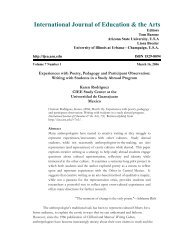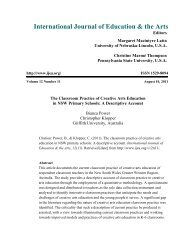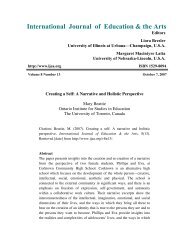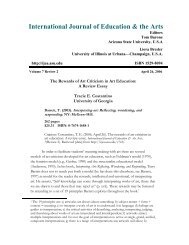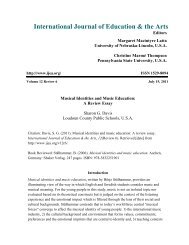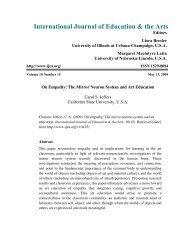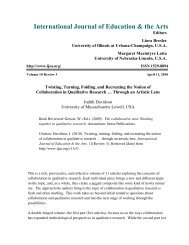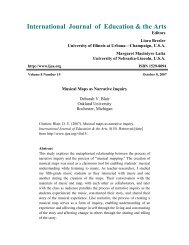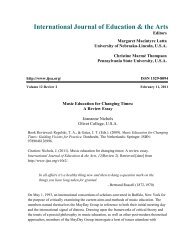Drawing with light and clay: Teaching and learning in the art studio ...
Drawing with light and clay: Teaching and learning in the art studio ...
Drawing with light and clay: Teaching and learning in the art studio ...
Create successful ePaper yourself
Turn your PDF publications into a flip-book with our unique Google optimized e-Paper software.
IJEA http://ijea.asu.edu 4<br />
With <strong>the</strong>se questions <strong>in</strong> m<strong>in</strong>d, we pulled several <strong>the</strong>mes out of our <strong>in</strong>dividual doctoral<br />
research projects, which <strong>in</strong> p<strong>art</strong> focused on how <strong>learn<strong>in</strong>g</strong> <strong>in</strong> <strong>the</strong> ceramic <strong>art</strong>s (Albertson,<br />
2001) <strong>and</strong> <strong>in</strong> photography (Davidson, 2000) <strong>in</strong> school <strong>and</strong> community-based sett<strong>in</strong>gs<br />
worked to support <strong>and</strong> engage students who were struggl<strong>in</strong>g <strong>with</strong> some aspect of <strong>the</strong>ir<br />
school<strong>in</strong>g. Additionally, we considered our own experiences of work<strong>in</strong>g <strong>with</strong> pre-service<br />
teachers between 1995-2006 at Concordia University <strong>in</strong> Montreal, <strong>the</strong> University of<br />
Ma<strong>in</strong>e <strong>in</strong> Orono, <strong>and</strong> <strong>the</strong> University of Wiscons<strong>in</strong>-Milwaukee. Just as importantly, we<br />
analyzed a variety of <strong>art</strong>ifacts related to <strong>the</strong>se teach<strong>in</strong>g experiences. For example, we<br />
considered <strong>the</strong> physical organization of our respective teach<strong>in</strong>g <strong>studio</strong>s, our course<br />
syllabi, <strong>and</strong> <strong>the</strong> content we deliver <strong>in</strong> ceramics, photography <strong>and</strong> <strong>in</strong> our <strong>art</strong> education<br />
courses. Through a careful consideration of <strong>the</strong> material outl<strong>in</strong>ed above, we identified<br />
several qualities <strong>and</strong> components that helped us to see how <strong>the</strong> media, <strong>the</strong> technical,<br />
social, <strong>and</strong> affective aspects of <strong>learn<strong>in</strong>g</strong> <strong>in</strong> <strong>the</strong>se two <strong>art</strong>istic discipl<strong>in</strong>es help to engage<br />
students <strong>with</strong> a range of needs <strong>and</strong> <strong>learn<strong>in</strong>g</strong> styles. In order to discuss our thoughts, <strong>and</strong><br />
for purposes of clarity, we have identified eight key elements that we see as critical to<br />
encourag<strong>in</strong>g students to give <strong>the</strong>mselves over to <strong>the</strong> <strong>learn<strong>in</strong>g</strong> experience <strong>with</strong> less fear of<br />
failure, anxiety, self-doubt, <strong>and</strong> resistance.<br />
What follows is a discussion relat<strong>in</strong>g our experience of teach<strong>in</strong>g <strong>and</strong> <strong>learn<strong>in</strong>g</strong> <strong>in</strong> <strong>the</strong><br />
ceramics <strong>and</strong> photography <strong>studio</strong>s, p<strong>art</strong>icularly <strong>with</strong> regard to learners who are struggl<strong>in</strong>g<br />
<strong>with</strong> some aspect of <strong>the</strong>ir school<strong>in</strong>g. We will consider how <strong>learn<strong>in</strong>g</strong> <strong>and</strong> <strong>art</strong>istic<br />
expression <strong>in</strong> <strong>the</strong>se very different, yet highly related, <strong>art</strong>istic fields can offer teachers <strong>and</strong><br />
students potent <strong>and</strong> <strong>in</strong>spir<strong>in</strong>g ways of explor<strong>in</strong>g <strong>and</strong> express<strong>in</strong>g ideas <strong>and</strong> feel<strong>in</strong>gs,<br />
exam<strong>in</strong><strong>in</strong>g alternative possibilities, <strong>and</strong> build<strong>in</strong>g community. By br<strong>in</strong>g<strong>in</strong>g <strong>the</strong>se attributes<br />
to <strong>light</strong>, it is our goal to illustrate some of <strong>the</strong> ways that all teachers might build pathways<br />
to engagement for <strong>the</strong>ir “tough audiences” <strong>in</strong> subject areas rang<strong>in</strong>g from science to social<br />
studies.<br />
Mov<strong>in</strong>g Toward Engagement – Eight Key Elements<br />
Community <strong>and</strong> Citizenship:<br />
A sense of belong<strong>in</strong>g to a community is an outgrowth of work<strong>in</strong>g <strong>in</strong> <strong>the</strong> <strong>clay</strong> <strong>studio</strong> or <strong>the</strong><br />
darkroom. While concepts of community <strong>and</strong> citizenship are recurr<strong>in</strong>g <strong>the</strong>mes <strong>in</strong> this<br />
essay, this section focuses on how <strong>the</strong> technical <strong>and</strong> physical qualities of <strong>the</strong>se materials<br />
promote a sense of awareness of o<strong>the</strong>rs <strong>with</strong><strong>in</strong> a group. We suggest that <strong>the</strong>se experiences<br />
have <strong>the</strong> potential to reach out past <strong>the</strong> doors of <strong>the</strong> <strong>clay</strong> <strong>studio</strong> or darkroom, help<strong>in</strong>g to<br />
enhance students’ <strong>in</strong>terpersonal relationships <strong>in</strong> all aspects of <strong>the</strong>ir lives.




